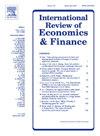Automotive industry development versus environment and policy:An integration of system dynamics and life cycle assessment
IF 4.8
2区 经济学
Q1 BUSINESS, FINANCE
引用次数: 0
Abstract
This study integrates system dynamics (SD) and life cycle assessment (LCA) to investigate the dynamic mechanisms and impact pathways shaping the development of China's automotive industry. Through an extensive review of relevant literature, a comprehensive analysis of key factors influencing the industry's growth was conducted, leading to the formulation of causal loop diagrams and stock-flow models. The dynamic equations and parameterization were established accordingly. Life Cycle Assessment (LCA) methodology was integrated into the model to evaluate the environmental impact of electric vehicles (EVs) across their full lifecycle, from production and use to end-of-life disposal. This allowed for a more holistic assessment of pollutant emissions and resource consumption, providing a clearer understanding of how different factors influence the sustainability of EV adoption. Upon validating the model, system simulations were performed to analyze the development trajectory and critical factors driving the adoption of new energy electric vehicles (EVs). Based on the simulation results, this study offers policy recommendations aimed at promoting the sustainable growth of China's automotive sector. These recommendations focus on areas such as government subsidies, technological breakthroughs, the construction of charging and battery-swapping infrastructure, consumer market development, and environmental regulation based on LCA findings. The inclusion of LCA ensures that these policies not only support industry growth but also mitigate environmental impacts, providing practical and strategic insights for ensuring the long-term viability and sustainability of China's automotive industry.
汽车工业发展与环境和政策:系统动力学和生命周期评估的集成
本研究结合系统动力学(SD)和生命周期评估(LCA),探讨中国汽车产业发展的动力机制和影响路径。通过广泛查阅相关文献,全面分析影响行业增长的关键因素,形成因果循环图和存量流模型。据此建立了动力学方程和参数化。该模型集成了生命周期评估(LCA)方法,以评估电动汽车(ev)从生产、使用到报废处置的整个生命周期对环境的影响。这样可以更全面地评估污染物排放和资源消耗,更清楚地了解不同因素如何影响电动汽车采用的可持续性。在验证模型的基础上,进行了系统仿真,分析了新能源电动汽车的发展轨迹和驱动因素。基于仿真结果,本研究提出了促进中国汽车行业可持续发展的政策建议。这些建议侧重于政府补贴、技术突破、充电和电池交换基础设施建设、消费者市场开发以及基于LCA调查结果的环境监管等领域。纳入LCA确保这些政策不仅支持行业增长,而且减轻环境影响,为确保中国汽车工业的长期可行性和可持续性提供实用和战略见解。
本文章由计算机程序翻译,如有差异,请以英文原文为准。
求助全文
约1分钟内获得全文
求助全文
来源期刊
CiteScore
7.30
自引率
2.20%
发文量
253
期刊介绍:
The International Review of Economics & Finance (IREF) is a scholarly journal devoted to the publication of high quality theoretical and empirical articles in all areas of international economics, macroeconomics and financial economics. Contributions that facilitate the communications between the real and the financial sectors of the economy are of particular interest.

 求助内容:
求助内容: 应助结果提醒方式:
应助结果提醒方式:


